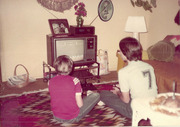tv ABC7 News Getting Answers ABC March 4, 2021 3:00pm-3:30pm PST
3:00 pm
bay area f a safe and secure future. this is abc 7 news. hi there. i'm kristen sze. welcome to our daily program called "getting answers." we ask experts everyday your questions at 3:00 to get answers in realtime. today we dive into new changes in california's vaccine and reopening rules. governor newsom setting aside 40% of vaccine doses for communities in the bottom quarter of the state in terms of income and other socioeconomic factors. now this is his latest push to address vaccine equity in the wake of data showing those impoverished communities have a disproportionately large number of covid cases and deaths. let's begin with another big move governor newsom making
3:01 pm
today. opening up youth sforts across the state, even those played indoors as a result of a lawsuit filed by a high school football player in san diego. >> it now goes down to the local decisions. and i would ask those local authorities that have the ability to let them please, let them play. it's time. these kids have had nothing for 11 months. and they truly,ruly need this. >> local counties and districts can choose to opt out. masks will be required for coaches and players when they're on the bench but not when they're actually exciting. each player can have up to four family members attend games. joining us to talk about this are sahr are football coach patrick walsh and 14-year-old stella book, volleyball player who sued the state. welcome, stella, starting with you, how do you feel about the news giving you a path to resume
3:02 pm
volleyball play for the school. >> i'm happy and hopeful that we'll be able to play. it's not over yet. because we still need the cif sections to extend the end date so that we can fooul have a meaningful season and long enough. but i am really happy that we have gotten in step. >> right, that's the next step, right, to see if they can extend the season because you are so into it already. patrick, you're a golden state high school football coaches group worked closely with the let them play move to push for youth sports in california. the exact language should be posted by the state within a day or so. but give us the bullet points of the deal. >> basically all sports are open now. we started the quest with three million kids on the bench. and today they're all off the bench. but with certain parameters that, you know, are necessary during this pandemic. the first and foremost is testing. and the state is going to provide testing.
3:03 pm
and also a partnership with covid 1111 is going to make sure it's happening for all kids across the state of california. that's the biggest things. sports will have to test until their sport gets to the tier, which indoor sports will be the yellow tier which is a long way away to be honest with you. >> just because there is this path, patrick, do you think local counties and school districts will actually embrace it and say let's do it? because as you said, testing is the key. and that's not necessarily easy for all school districts to commit to, even if there is a freeway for them to do it. >> yes, i mean, i think it's the adult's responsibility to clear all road blocks for kids to play. so i do not support any county or district going above this and using testing as a way out to not put the kids back on the courts or on the fields. i beliett de with the partnerships we have with fema and the state of california i believe it can get
3:04 pm
done safely. >> stella, right now volleyball is in the yellow tier. it was in the orange when the governor first unveiled this guidelines along with football. but then, you know, it got moved to yellow with basketball. how do you feel about that? do you think that's where your sport belongs, in the yellow tier? >> no, i think there is -- there is a lot of data to show that indoor volleyball,o can be played expensively. and yellow tier is pretty far away, pretty unreachable. so i think it isn't very reasonable, because volleyball and indoor sports can be played safely. and we have seen a lot of data to show that. >> i've heard some people describe volleyball as kind of like girls' football. and stella, park, i want you to weigh in on the importance of this sport in particular to girls. >> yeah, i think that's an accurate description. because i think football is a sport where a lot of boys play
3:05 pm
it. and it's, like, where you can come together as a team and to represent your high school. and i think volleyball is one of the most popular sports for girls. so since so many girls play volleyball and so many boys play football, they're both kind of similar in the sense that they're the most popular sports. >> yeah, patrick, i know you coach football. talk about the risk level as you see it in terms of, you know, football being in orange and volleyball being inoutdoors. but yes there is more contact in football as well. >> yeah, i didn't support the state dropping, you know, girls volleyball to the yellow. i think that and science sport support that being an orange sport, maybe even red. because there is no contact. the girls can wear masks comfortably. which i talked to -- is that right, stella? i think that's kind of the norm now in this time.
3:06 pm
so where stella draws comparisons on the spiritual level it's a totally different sport because of the lack of contact. they're not tackling and blocking each other. i think it should be an orange sport. but i also think with the testing component that football has td and now volleyball, that's now eliminated, the tier is eliminated we can roll out testing and get the girls on the court right now. >> let's say the testing component is done and the school districts commit to it, doesn't each school still have the problem of allocating limited field time or court time, if you will? now you have what, two three months left of the school year. and you're squeezeding every single sport in. so, patrick, talk from the standpoint of saying i got boys basketball, girls basketball, two volleyball, badminton. how do you decide that? >> that's tough. that's where the facilities and time crunch are coming to a head. you know, we've paved the way at the top level of the state, top
3:07 pm
level of the government to create the problems. prior to this morning and prior to the announcement made on february 19th we didn't have the problems at all because no one was allowed to do anything. we welcome the problems and we hope we can work together. i know for me as the football kroech we're working with loo cross, soccer. we've cut our practice times down. hopefully the adults now can be of mind to get the schedules worked out, gym space, field space to provide relief for the kids like stella that deserve so much. >> well, stella, a lot of kids especially in volumery ball do play club, right? that's been going on. why still fight so hard to have the school season? >> i think being able to represent your school and wear that jersey, and just bond with that team for four years is a completely different experience. and not to mention that club can't actually -- couldn't compete up until the new
3:08 pm
agreement. so, yeah, i think, a, that club couldn't compete. and b, that playing for your high school is just a whole different thing. it's a great feeling to represent your school and to have that experience. >> um-hum. and patrick, i want to ask you just, you know, i know technically, even if certain sports weren't allowed to compete, they really were. i mean, there are a lot of people doing it, either just doing it and don't care or going out of state where they are allowed. do you feel like there's been a system of haves and have notts? >> absolutely. that was one of the main points why we wanted to get the kids back on the fields through our schools. because there is nothing -- there is nothing that can replace high school sports and youth sports. being able to offer that at the community level now is really big for everybody. you know, not everybody can jump on a plane and go to arizona and play in a youth volleyball tournament or any of that sort of thing.
3:09 pm
the fact that we now in our community here -- let's talk about san mateo, have that opportunity to provide youth sports from kindergarten through high school, it's now upon us to get that done for them. yes i agree 100%. the haves and have notts were splitting. and now we can bring back sports for everybody. >> i got 30 seconds left. but patrick your football team has been practicing, geting ready. no covid cases, no issues everybody keeping safe. >> yes. >> and stella are you dropping the lawsuit? >> we -- yes. we are agreeing to the settlement agreement. >> but still pushing for volleyball from yellow back to oregon, right. well thank you both for talking with me and i know you're happy about the development but let's keep the conversation going. >> absolutely. thank you. >> thank you. >> thank you. all right. speaking of equity, coming up next we're digging into california's plan to speed up reopenings by changing the
3:12 pm
ten seconds or five seconds. welcome back. big shift today in the way california distributes its limited vaccine doses. today governor newsom announced that 40% will now be earmarked for around 400 zip codes in california, that correlate with the highest poverty levels. that is because those communities have been hit hardest by covid. >> just consider low-income households earning less than pacted a year househol wseom are north of $120,000.
3:13 pm
>> in addition to income, the state is also considering education level. housing status and access to transportation. so joining us now to talk about the new approach and other new covid developments is ucsf infectious disease specialist dr. peter chin-hong. thanks for joining us, dr. chin-hong. >> thanks for having me on abc kristen. >> go ahead and explain to us if you will the behind the new vaccine distribution formula. >> so the rationale is both evidence-based as well as reflects what's happening in reality. because, of course, we've been doing vaccination rollout for some time now in california. so from an evidence-based perspective, we know that latin x populations are three times not only to get infected but to die of covid. and other communities of color suffer a similar disparity in terms of how the bad stuff from
3:14 pm
the pandemic has affected those communities. and then from a real boots on t there was as much as a four-times difference between the richer communities and the poorer communities in terms of how vaccines have actually played out, even with people paying attention in the communities. so povbly what we are doing is not working that well. so we need to be little bit more forceful. >> do the 400 zip codes, do they correlate mainly with race or if they also correlate perhaps with occupations that may put people more at risk? >> i think it's all mixed in, kristen. so it is geographically specific. so it really targets socioeconomic status. and like you pointed out, it's a mix of income at a patient level, housing, access to
3:15 pm
transportation. it's almost race abethnicity and agnostic but representing the communities of color. >> like in the bay area, which pockets or neighborhoods would you say fall in that category where they have taken the biggest brunt of covid deaths and cases? >> they reflect places that we at ucsf tried to make inroads in terms of even from the diagnostic days, trying to make inroads into testing. so the mission, particularly some of the zip codes. bay view, hunter's point and in alameda county fruit veil, all of those areas. when you think about southern california, where there is some data actually in vaccine disparities, we are talking about, you know, south l.a. and some of those communities, in contra to other communities like brentwood, santa monica, where there's been data showing this disparity and how many people are getting access to vaccines. >> okay. well since vaccines are still
3:16 pm
limited i want to ask you, what about people with certain disabilities or underlying health conditions, right? because people under 65 with those conditions. they were supposed to be religion by mid-march for vaccinations. dr. ghalily said today they won't be left out as many live in the disadvantaged areas. but many also don't. those who don't live in the areas won't the potential supply for them be reduced? >> i don't think it will be reduced, because this is a percentage. but i really think based on what i know from the production lines and the approval of j&j and what's in the pipeline, and the increase in production of pfizer and moderna, and the partnership with, for example, j&j and with merck now. that a percentage with an increase in the storage room of vaccines will mean that they should be enough, even for people with disabilities in the non-disadvantaged areas.
3:17 pm
>> all right. well, hopefully that will be the case. because a lot of people are very nervous right now as you heard. 90,000 appointments had to be cancelled with sutter health due to vaccine shortages. and i wonder if this policy changes anything about the eligibility criteria that we have in place right now. it doesn't, right? >> i don't think it will change. >> okay. >> anything with eligible opinion it's just the diversion. and a rough diversion. i feel like if -- because they're going to be following data i hope. so if there seem to be less disparities in geographic areas then they will reallocate it to be more geographically agnostic. >> okay. yesterday we heard that a group that got vaccines at the fema coliseum site apparently got a dose that was smaller than they were supposed to get. what happened there? and what is the impact? there is some worry over omy gosh it w't dose. >> the observation by a couple of emts apparently who who
3:18 pm
were -- there was a syringe and vial and it seems there was stuff in the vial because the syringe didn't go all the way down. but there wasn't confirmation yet that that actually translated in less than 0.3 milliliters which is the recommended dose. i still think we need more information. we have some cursory information from fema and the state saying there wasn't any discrepancy. but even if it was 0.2, when you go back to the early new england journal of medicine studies, 0.2 and 0.3 are similar in terms of the antibody response elicited. that's one thing. the second thing is one dose by itself gives 90% protection in general. so the combination of potentially a lower dose and a second dose coming up would sort of make things equal, in my respect. my bottom line is not to pan
3:19 pm
inkic. >> okay. >> but i think it would be great to know what really happened. >> and hopefully won't happen again. big news today, the cdc was supposed to release guidance for vaccinated americans today. is now delaying that move for all parties to get on the same page. hopefully tomorrow -- that's a little disappointing. but when it comes out what do you expect they will say? >> i will hope that they will say that it's officially okay for vaccinated people to get together in small groups without protection. i think many health care professionals strongly believe that. of course, you don't want to be having a arrive party with vaccinated people, because it's more unregulated. chances of two people who didn't respond will be higher in a huge crowd. but i think this messaging needs to be nuanced and positive. i think so far it's just a don't do drugs message, black and white, wear masks. but i think we need more nuance. >> okay.
3:20 pm
at about tliachould you had travel or be encouraged to travel? >> i think it's going to be safe to travel with masks on, because we can't, again, there will be a mixture of vaccinated and unvaccinated people of different stages even since vaccination. so potentially transmission. but with a mask i think it's going to be okay. i think the biggest change for travel is a mental shift that, you know, i think, you'll be aly bit more at peace of mind in that ourn journey. >> a short break on the air but when we come back we'll talk about variants, sports restarting in
3:22 pm
3:23 pm
k and brazilian ones much more contagious. can you give us details? >> yes, i think the most interesting new information is about the brazilian variant. it is, as we expect, very similar to the south african variant in terms of not having two superpowers. not only stickier like velcro instead of it whizzing by. by stickier but the brazilian like the south african is more vaccine resistant. we definitely don't want it to set up shop. the uk variant has one superpower like the california vaern, our own variant. that one is i think people are thinking it's more transmissible than originally thought, which also means that if it's going to be the dominant variant in the u.s. by the end of march, as the cdc predicts, it's just a little bit less forgiving. it's like we have to do what we have to do except exclamation
3:24 pm
point. >> mash sha wants to know, do you recommend nursing moms get vaccinated? any risks with that? >> nursing moms and pregnant women haven't been formally studied in the trials. but so far quite a number of those women have received vaccinations in the u.s. we haven't had any negative reports. from an infectious disease perspective these are non-live viruss. i wouldn't expect them to cause any problems either for the growi growing fetu or the transmission in breast milk. >> vivian wants to know- dsh you know we are talking about sports resuming. she wants to know how does dr. chin-hong about outdoor sports competing without masks on. when on the sidelines or on the bench you have to wear mask but actually competing you don't have to wear them.
3:25 pm
>> so far the data in the u.s. has been relatively promising with outdoor sports. this is very different from indoor sports. there have been a few outbreaks in maine with indoor ice hockey. but for outdoor sports, the main points where there is bad stuff happening is in locker rooms when people get together whereo, share meals, take off masks. during the game it seems to be actually okay. >> okay. hey, as more schools reopen, some are resume band practice, for example. we talked about one school in novato has musicians, middle schoolers wearing masks with slits in this them as they play instruments. what do you think about that? >> i think it's a little bit worrisome. well, first of all, let me give the broad view. middle schoolers in general, particularly younger age range are less likely to get as well as transmit. it will be different if i was
3:26 pm
having brand practice with fellow unvaccinated adults if i because you can't just protect your mouth. that whole wind instrument is just blowing out all over the place. it's a delivery system for potential droplets. those are the things worrisome about that particular scenario. >> earlier we were talking about sutter health cancelling appointments. and there are some people having to wait longer for the second dose. how long can you really delay that second dose and have it still be fully protective? >> yes, so, we start with the cdc guidance which is six weeks, instead of three to four weeks. six weeks is okay for waiting for your second dose -- for the two-dose series. that comes from uk data and that's where they got the number from. meaning people waited this much time, still had good response. but biologically speaking, as an
3:27 pm
infectious disease doctor, i think it's okay if you waited a little bit longer if you had to. and my -- you know, we know that in natural infection, which is not as robust as vaccine immunity, the immunity you get from natural infection can last probably seven months. there is more variability. but that's the case. in fact the cdc says wait three plonts. i think it's going to be okay. >> thank you so much. we'll take a short break on
3:29 pm
3:30 pm
vaccinations based on income, the zip codes, 400 zip codes with the lowest incomes will get 40% of the vaccines u tonight, several developing stories as we come on the air. ramping up vaccinations across this country. 2 million shots a day now. long lines in orlando. the national guard assisting in kansas city. yankee stadium with shots around the clock. and tonight, lifting mask mandates. the texas governor explaining why, after criticism from president biden. and alabama's republican governor saying her state's mask mandate has worked and will remain in effect. >> wre seeing in the senate as we come on the air tonight. the debate now under way over help for americans in this pandemic. the president's covid relief bill. vice president kamala harris and the tie-breaking moment opening the debate. will this become a sign of the times in this 50/50 senate? and news on those 1,4 $00
51 Views
IN COLLECTIONS
KGO (ABC) Television Archive
Television Archive  Television Archive News Search Service
Television Archive News Search Service 
Uploaded by TV Archive on

 Live Music Archive
Live Music Archive Librivox Free Audio
Librivox Free Audio Metropolitan Museum
Metropolitan Museum Cleveland Museum of Art
Cleveland Museum of Art Internet Arcade
Internet Arcade Console Living Room
Console Living Room Open Library
Open Library American Libraries
American Libraries TV News
TV News Understanding 9/11
Understanding 9/11



























